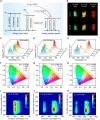On-demand modulating afterglow color of water-soluble polymers through phosphorescence FRET for multicolor security printing
- PMID: 35427159
- PMCID: PMC9012460
- DOI: 10.1126/sciadv.abk2925
On-demand modulating afterglow color of water-soluble polymers through phosphorescence FRET for multicolor security printing
Abstract
Developing full-color organic ultralong room temperature phosphorescence (OURTP) materials with continuously variable afterglow emission is of considerable practical importance in diverse optoelectronic applications but remains a formidable challenge. Here, we present an effective strategy for on-demand engineering of afterglow color in water-soluble polymeric systems via efficient phosphorescence Förster resonance energy transfer. Using a blue afterglow emitting water-soluble polymer as host and a series of fluorescent emitters with varied emissive colors as guests, afterglow emission is rationally modulated, conferring the full-color afterglow emission ranging from blue to red and even white with ultralong lifetimes up to 4.2 s and photoluminescence quantum yields of 36%.These water-soluble multicolor-emitting polymeric afterglow systems can function as OURTP security inks, and multilevel information encryption was successfully established by RGB-based multicolor security printing. These results present important guidance in developing high-performance afterglow polymers with on-demand color tuning ability for remarkable optoelectronic applications.
Figures





References
-
- An Z., Zheng C., Tao Y., Chen R., Shi H., Chen T., Wang Z., Li H., Deng R., Liu X., Huang W., Stabilizing triplet excited states for ultralong organic phosphorescence. Nat. Mater. 14, 685–690 (2015). - PubMed
-
- Zhao W., He Z., Tang B., Room-temperature phosphorescence from organic aggregates. Nat. Rev. Mater. 5, 869–885 (2020).
-
- Kabe R., Adachi C., Organic long persistent luminescence. Nature 550, 384–387 (2017). - PubMed
-
- Bolton O., Lee K., Kim H., Lin K. Y., Kim J., Activating efficient phosphorescence from purely organic materials by crystal design. Nat. Chem. 3, 205–210 (2011). - PubMed
Publication types
LinkOut - more resources
Full Text Sources

